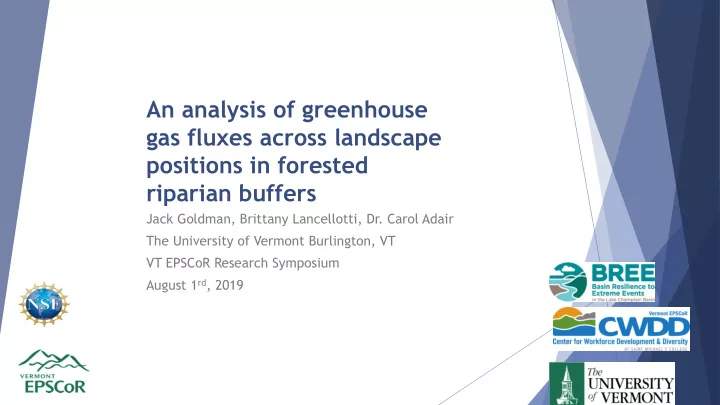

An analysis of greenhouse gas fluxes across landscape positions in forested riparian buffers Jack Goldman, Brittany Lancellotti, Dr. Carol Adair The University of Vermont Burlington, VT VT EPSCoR Research Symposium August 1 rd , 2019
What makes Riparian zones so complex and Nitrous Oxide so important? Riparian zones play a major role in Nitrogen sequestration Vulnerability • Storage of biomass • Immobilization and retention • Nitrification/Denitrification- removal of Nitrogen from the • soil Nitrous Oxide (N2O) (Klaus et al., 2013) 300 global warming potential over 20 years • 6.24% global radiative force •
What drives variability in Nitrous oxide (N2O) fluxes? Hot spots- greater biogeochemical activity in proximity to landscape positioning Hot moments- short period of time with heightened biogeochemical rates after an event (McClain et al., 2003) (USGS., n.d) Physical parameters Dry ambient What causes this Oxygen concentration • condition hot moment? Volumetric Water Content (VWC) • Temperature •
Research Question How does N 2 O vary temporally and spatially along a dry and wet riparian buffer zone in a forested environment? Research implications What are major drivers of N 2 O fluxes Hot spots vs. Hot moments and what occurs more frequently Understanding soil microbial processes
How this fits into Basin Resiliency Resiliency of the Lake Champlain Basin Soil biogeochemistry processes Baseline riparian zone data
The process Study Site Forested riparian zone perpendicular to a stream located in Lake Champlain Missisquoi Watershed • Samples were taken at two different locations an upland site (dry) and wetland site (wet) • • Both sites had the same features: Upland, Upper edge, Core, Lower edge and Wet Upland Upland Dry Transect Wet Transect Upper edge Core Lower edge Lower Stream Wet Stream Upper edge Wet Core edge Riparian zone Riparian zone Field procedures • High Frequency soil sensor provided O2, VWC, and temperature at different depths (15cm, 30cm, 45cm, 60cm) A gas chamber was used to capture greenhouse gas emissions from the soil • • Samples was taken every 15 minutes for 45 minutes and transferred to evacuated vials
The wet sites have high N2O fluxes Upland Wetland Transect Lower Stream Upper edge Wet Core edge Riparian zone
The dry sites drivers…. Upland Upper edge Dry Transect Core Lower edge Stream Wet Riparian zone
Pretty consistent oxygen concentrations throughout the pits
Take home points There are higher N 2 O fluxes in the wetter pits Zero fluxes at the upland and wet sites Temporal variation suggests that there may be ‘hot moments’ of N 2 O production
Further Research Nitrate and Ammonia Seasonal variability Plant communities Soil carbon and nitrogen
References Mith, K. A. S., All, T . B., Onen, F . C., Obbie, K. E. D., Assheder, J. M., Ey , A. R., … Rey, a. (2011). Exchange of greenhouse gases between soil and atmosphere: interactions of soil physical factors and biological processes. European Journal of Soil Science, 54(4), 1 – 16. https://doi.org/10.1046/j.1365-2389.2003.00567.x Klaus, B.-B., M., B. E., Michael, D., Ralf, K., & Sophie, Z.-B. (2013). Nitrous oxide emissions from soils: how well do we understand the processes and their controls? Philosophical Martin, T . L. (1999). Review: Denitrification in temperate climate riparian zones. Water, Air, and Soil Pollution , 111 (1 – 4), 171 – 186. https://doi.org/10.1023/A:1005015400607 USGS. (n.d.). Diagram showing hypothesized changes in GHG emission pathway. Retrieved from https://www.usgs.gov/media/images/diagram-showing-hypothesized- changes-ghg-emission-pathway
Thank you so much! Questions?
Recommend
More recommend